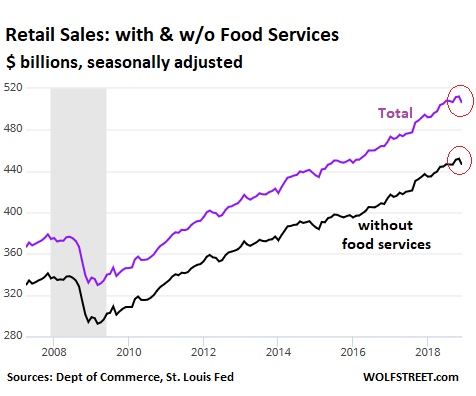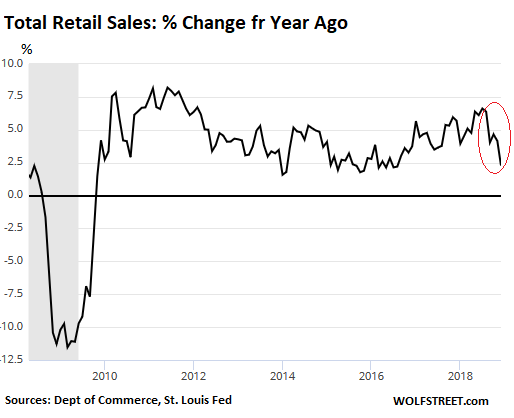Wolf Richter wolfstreet.com, http://www.amazon.com/author/wolfrichter
Consumer exuberance maxed out last summer and has since changed direction.
The headlines today were all about retail sales that “fell most since 2009,” or as the WSJ put it, “at Fastest Pace since 2009,” or as CNBC put it, “so bad it’s either suspect data or a recession warning.” So let’s see.
- Total retail sales, including food services sales such as at restaurants, rose 2.3% in December from December 2017.
- For the year 2018, retails sales rose 5.0% to $6.04 trillion.
- Excluding sales at gas stations, retail sales in December rose 2.5% from a year ago.
- Retail sales without food services rose 2.1% year-over-year in December.
So what was all the hand-wringing in the headlines about? That drop-off at the end of the line (circled in red):

These drop-offs are common in retail sales, as you can see in the chart. They just don’t normally happen in December. Retail sales are very seasonal, and so the seasonal adjustments are huge, and the figures are only as good as the seasonal adjustments.
Also, today’s data pile was the “advance estimate” of retail sales. The Commerce Department will revise it, and these revisions can be fairly large, in either direction.
So why did the media go into panic mode?
The reason for the panic was the monthly decline in sales, seasonally adjusted, from November to December:
- Total retail sales -1.2% from November to December
- Retail without food services -1.3% from November to December.
On a “not seasonally adjusted” basis, sales in December rose 8.6% from November. But this increase was lower than the NSA increase a year earlier of 12.2%. December, the peak of holiday shopping season, was the peak in 2018 as well, but that peak might not have been so hot.
Growth in retail sales on a year-over-year basis maxed out in July and August at a blistering 6.6% and 6.3% respectively. This growth rate has since declined, and in December was 2.3%. In the chart below, note the trend of declining growth since last summer. This trend takes year-over-year growth rates to the lower range of the post-Financial Crisis period.

While stores in most major categories booked year-over year sales increases, there were some that even on a year-over-year basis, booked a drop in sales:
- At sporting goods, hobby, musical instrument, and book stores: -13.0%
- At department stores, a category whose sales have plunged for 17 years: -2.8%
- At furniture stores: -0.2%
Some blamed the government shutdown’s effect on consumers who work for the government, but the actual paychecks didn’t stop coming until January. So if this had an impact in December, I dread to see its impact in January. But I doubt that the impact was significant in December, and that we can blame what happened in December on the government shutdown.
Whether or not the month-to-month sales decline in December was a fluke, or bad data, or a huge red flag, the problem is the trend: a decline in year-over-year growth rates from the peak last summer back to the lower range of year-over-year growth rates in the post-Financial Crisis period, as shown in the chart above.
Clearly, the exuberance of consumers maxed out last summer and is now returning to lower levels.
Looking at the chart above, the year-over-year growth rates change sharply all the time, and what I’m seeing in the chart doesn’t make me panic yet, but it makes me nervous.
What will make me panic is if year-over-year growth rates in retail sales break out through the bottom of the range and drop below 2% or worse, below 1%.
Inflation and population growth currently combined amount to over 2.5%. This is a figure to keep in mind when year-over-year retail sales growth drops below that rate: Meaning that at that moment – and we’re at that moment now – adjusted for inflation, per-capita year-over-year retail sales growth may be actually turning negative. If this gets confirmed over the next few months and morphs into a more enduring trend, where individual consumers across the US on average cut back, it’s panic mode.
“A development that is surprising during a strong economy and labor market”: New York Fed. Read… Subprime Arrives: Auto-Loan Delinquencies Spike to Great Recession Levels